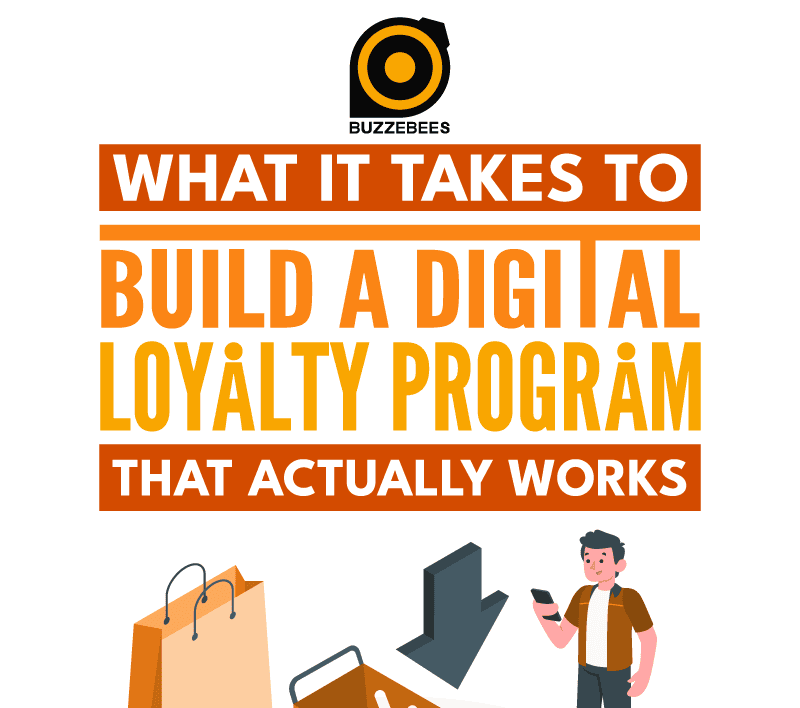Filipino consumers are amongst the most internet and social media users worldwide. An average Filipino spend an average of 8 hours and 52 minutes online daily, placing the Philippines third globally in daily internet use.
It is no surprise that countless brands digitalized their loyalty programs to tap into a market focused on gadgets and digital platforms. Online customer loyalty platforms have become a key tool to interact with consumers in real time and stand out in a crowded marketplace.
However, for Philippine enterprises, the challenge is not deciding whether to create a digital loyalty initiative; it’s on how to build one that actually works.

How to Build an Effective Digital Loyalty Program
A program that resonates with Filipino consumers must balance convenience, personalization, and innovation while being simple enough for everyday use. Here is a step-by-step guide to building a loyalty program that delivers real impact.
- Define Clear Objectives and Target Audience
Every effective program starts with clarity of purpose, so companies should first establish what they want to achieve. Whether it is to increase repeat sales or enhance customer retention, the bottom line is that the company should decide based on their needs.
The objectives must also align with the target audience. Filipino consumers differ in spending behavior, digital adoption, and brand preferences. A retail chain may target millennials and Gen Z, who rely heavily on mobile apps, while a financial institution may focus on professionals who value cashback or rewards points for bills payment.
- Choose the Right Digital Loyalty Program Model
Not all programs are built the same. Filipino companies should choose a model that aligns with both customer expectations and business goals.
Some common virtual loyalty programs models include:
- Point-based programs reward customers with points for purchases or other actions, such as social media engagement, which can be redeemed for rewards.
- Cashback Programs give consumers a percentage of their spending back as cash or store credit for future use, mostly appealing to budget-conscious shoppers.
- Gamified Programs use game elements, such as challenges, badges, and leaderboards, to reward engagement and repeat interactions.
Companies in different industries adopt these loyalty systems enhance customer engagement and drive loyalty through customized rewards and incentives.
- Select a Digital Platform
The platform used is the backbone of any digital loyalty program. While there is plenty of popular software in the market, business should choose one that seamlessly integrates with the company’s existing systems. This could be a standalone mobile application, a dedicated website, or even a plug-in that works within popular social media platforms, such as Facebook and WhatsApp.
Ideally, the chosen CRM loyalty and engagement platform should connect smoothly with POS systems, e-commerce sites, mobile wallets, and other CRM tools.
Since many Filipinos access the internet via smartphones, mobile optimization is non-negotiable. Any successful loyalty program app should provide either QR code scanning for in-store transactions or connects seamlessly with e-wallets or online banks.
- Design an Engaging and Simple User Experience
Complicated mechanics discourage sign-ups and participation. Onboarding customers to the loyalty program should take just a few steps, ideally allowing sign-ups through social media or e-wallets.
Using game elements can make the virtual loyalty program more engaging and fun. Common features include:
- Points and badges are where customers earn points not only for purchases but also for other actions, which may include reviewing or sharing products on social media. Badges serve as visual milestones that celebrate achievements and motivate ongoing participation.
- Challenges and Missions encourage customers to complete specific tasks for rewards. For example, spending a certain amount within a given time frame will give them extra vouchers for their next purchase.
- Leaderboards and Rankings create competitive elements where customers can see how they rank against others, which fosters a sense of community and friendly competition.
- Time-limited rewards and bonuses that offer special challenges or bonuses creates urgency and excitement to participate.
A data-driven gamified online loyalty program puts personalization at the center. Using customer data analytics, businesses can tailor challenges, rewards, and communications that makes loyalty initiatives feel more relevant and engaging.
- Implement Multi-Channel Marketing and Communication
Building a program is only half the battle; promotion is equally critical. These days, e-commerce is closely tied to social media, with 86% of Filipinos shopping online via social platforms and 44% influenced by creators when making purchases. Social media platforms have become a crucial space online for promoting various offers.
Many businesses also partner with influencers to further promote their products and services, with Filipino brands allocating up to 50% of their marketing budget to influencers. Campaigns driven by online creators often see high engagement and significant sales impact, especially if the influencers align authentically with the brand and audience.
- Launch a Pilot Program and Collect Feedback
Rolling out a nationwide loyalty initiative without testing can be risky. A pilot program helps companies identify issues and refine features before a full-scale launch. By selecting a small segment of users, businesses can collect valuable feedback on user experience, reward appeal, and platform performance.
This stage provides insights into what customers love, what confuses them, and what could be improved. Continuous iteration based on feedback ensures smoother adoption during the full rollout.
- Scale and Continuously Improve
Rewards must be refreshed regularly to maintain interest, campaigns should be updated to reflect seasonal events, and customer insights must guide enhancements. Tracking KPIs such as retention rates, engagement levels, and incremental sales uplift ensures the program remains aligned with business goals.
- Ensure Compliance and Security
Trust is essential in digital loyalty initiatives, and companies must comply with the country’s Data Privacy Law (Republic Act No. 10173) to protect customer information and build that trust. This law governs how personal data is collected, processed, stored, and disposed of to ensure privacy and security.
The Data Privacy Act requires that companies obtain lawful and informed consent from customers before collecting personal data and clearly inform them about the purpose of data processing.
Build Your Loyalty Platform with Buzzebees!
In a market where competition is fierce and consumers are spoilt for choice, loyalty is the true differentiator. More Filipino customers gravitate toward businesses that consistently provide value, recognition, and convenience nowadays, and giving them efficient and engaging digital loyalty program can be a significant edge against competitors.
As a leading provider of digital loyalty and customer engagement solutions, Buzzebees has helped major enterprises across Asia design programs that are not only innovative but also proven to deliver measurable results. We empower Filipino companies to launch loyalty programs in the Philippines that truly resonate with today’s consumers.
Partner with us and start building smarter loyalty solutions tailored to your market!


